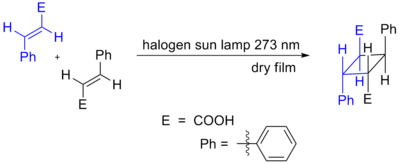Cycloaddition facts for kids
A cycloaddition is a chemical reaction between reactants with double bonds that get replaced by a ring structure. It is a pericyclic chemical reaction where "two or more unsaturated molecules (or parts of the same molecule) combine with the formation of a cyclic adduct in which there is a net reduction of the bond multiplicity." It is a cyclization reaction: it makes new ring of atoms.
Cycloadditions are named by the basic size of the molecules that are being brought together. This would make the Diels–Alder reaction a [4 + 2]cycloaddition, and the 1,3-dipolar cycloaddition a [3 + 2]cycloaddition. This type of reaction is a non-polar addition reaction.
Contents
Reaction mechanism
Heat can cause the double bonds to form a ring. Thermal cycloadditions usually have (4n + 2) π electrons participating in the starting material, for some whole number n. Because of orbital symmetry, most cycloadditions are suprafacial-suprafacial. Rarely, they are antarafacial-antarafacial. There are a few examples of thermal cycloadditions which have 4n π electrons (for example the [2 + 2] cycloaddition). These proceed in a suprafacial-antarafacial sense. For example, the dimerisation of ketene has a orthogonal set of p orbitals. Those p orbitals allow the reaction to proceed using a crossed transition state.
Light can also cause the double bonds to form a ring. Cycloadditions in which 4n π electrons participate can also occur as a result of photochemical activation. Here, one component makes an electron move from the highest occupied molecular orbital (HOMO) (π bonding) to the lowest unoccupied molecular orbital (LUMO) (π* antibonding). After the electron is promoted to the higher orbital, orbital symmetry allows the reaction to proceed in a suprafacial-suprafacial manner. An example is the DeMayo reaction. Another example is shown below, the photochemical dimerization of cinnamic acid.
Note that not all photochemical (2+2) cyclizations are cycloadditions; some are known to operate by radical mechanisms.
Some cycloadditions instead of π bonds operate through strained cyclopropane rings; as these have significant π character. For example, an analog for the Diels–Alder reaction is the quadricyclane-DMAD reaction:
In the (i+j+...) cycloaddition notation i and j refer to the number of atoms involved in the cycloaddition. In this notation a Diels-Alder reaction is a (4+2)cycloaddition and a 1,3-dipolar addition such as the first step in ozonolysis is a (3+2)cycloaddition. This notation uses parenthesis. The IUPAC preferred notation however, with [i+j+...] counts electrons and not atoms. It uses square brackets. In this notation, the Diels–Alder reaction and the dipolar reaction both become a [4+2]cycloaddition. The reaction between norbornadiene and an activated alkyne is a [2+2+2]cycloaddition.
Types of cycloaddition
Diels-Alder reactions
The Diels–Alder reaction is a [4+2]cycloaddition reaction.
Huisgen cycloadditions
The Huisgen cycloaddition reaction is a [2+3]cycloaddition.
Nitrone-olefin cycloaddition
The Nitrone-olefin cycloaddition is a [3+2]cycloaddition.
Formal cycloadditions
Cycloadditions often have metal-catalyzed and stepwise radical analogs, however these are not strictly speaking pericyclic reactions. When charged or radical intermediates are involved in a cycloaddition, or when the cycloaddition result is found in a series of reaction steps, they are sometimes called formal cycloadditions to make a difference from true pericyclic cycloadditions.
One example of a formal [3+3]cycloaddition between a cyclic enone and an enamine catalyzed by n-butyllithium is a Stork enamine / 1,2-addition cascade reaction:
Images for kids
See also
 In Spanish: Cicloadición para niños
In Spanish: Cicloadición para niños







![Intermolecular Formal [3+3] Cycloaddition Reaction](/images/thumb/2/26/3%2B3-cycloaddition.svg/600px-3%2B3-cycloaddition.svg.png)
